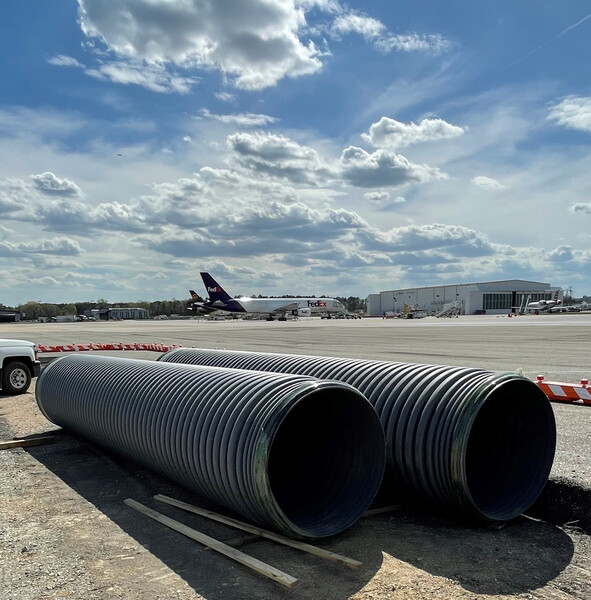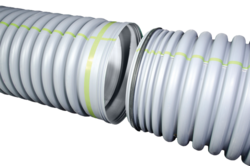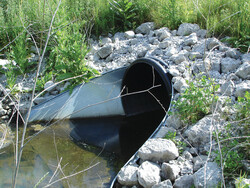PRODUCTS USED
- 2,000’ (610 m) of 24”-42” (600-1050 mm) HP Storm Dual Wall Pipe
- 500’ (152 m) of 30” (600 mm) N-12 Dual Wall HDPE Pipe
That meant significantly more impervious surface and, with it, more runoff.
Part of a continuing expansion plan, the recently completed Concourse B Apron Expansion and Deicing Facility includes some 66,000 square yards of commercial aircraft-grade concrete pavement that runs from the existing Concourse B apron to Taxiway F. The apron is configured to allow the glycol runoff to be sent to the collection pump station, which will discharge to the Henrico County sanitary system, while stormwater runoff is directed to one of two basins at the airport. “We put in two trench drains located in the middle of the apron,” explains Derek Johnson, project
manager for Hi-Way Paving of Hilliard, Ohio, the contractor on the job. “There is a valve system that diverts stormwater into the HP pipe or the glycol deicing chemical into a separate pipe.”
According to the American Airport Guide, 1,604,459 passengers flew in or out of Richmond International Airport in 2021, a 91% increase compared to the previous year. In October 2022, RIC had nearly 6,000 flights. Of utmost importance to the airport was the security of the system that would contain and convey both the deicing and stormwater runoff.
“We didn’t want any runoff to get into the groundwater,” says Wade Brooks, P.E., project manager for the engineering design firm, CP&Y, Inc. of Richmond, Virginia.
The Stormwater Management Facility at RIC consists of shallow marsh with two basins, inlet and outlet structures, plus shallow marsh plantings to treat stormwater runoff. Runoff goes into the White Oak Swamp Creek that flows to the Chickahominy River and into the James River, ultimately into the Chesapeake Bay. The recently completed project enhances the airport’s efforts to protect the water quality of the Chesapeake Bay.
“To do the new deicing facility we had to have a trench around the inlet that captures the deicing fluid,” Brooks says. “And during a regular rain, that can be diverted to go into the main storm drain system.
“We designed the apron stormwater drainage originally to use Class V reinforced concrete pipe because it’s pretty typical of what we do on airports. Sometimes it’s hard to get these government entities to make a change. They were stuck in their ways of using concrete pipe. After the bid, however, the contractor came to us and said, ‘Hey, to meet the schedule, there’s no way we can get concrete pipe; their supplies are behind schedule.’ That’s when we looked at something that can handle the weight of the various aircraft, and we thought of the Advanced Drainage Systems pipe, which we learned we could get delivered pretty quickly. And for scheduling purposes, and putting in as much pipe as possible in a day, it worked out really well to go with those products. For every day after the deadline that the project was not completed, it would have cost the contractor $15,000 a day.”
The layout called for nearly 2,000 linear feet of HP Storm pipe in diameters from 24 to 42 inches from ADS. For the deicing pipeline, 500 linear feet of solid-wall high-density polyethylene pipe was used.
“We didn’t want to contaminate the environment,” Brooks says. “And we wanted a quality pipe that would serve the purpose for the airport for a long time, because they don’t want to come back in and have to redo anything. Since it’s all FAA-funded, there’s an expectation that the money will be used the best possible way. Plus, we didn’t want any infiltration from the ground, which has a high water table, being close to the James River, and we were confident in the HP Storm gaskets. The ADS pipe also enabled us to actually reduce the size of the pipe that we had originally specced in, so we were able to save on size and costs.”
Being able to change the concrete pipe’s diameter from 27 inches to 24-inch-diameter HP Storm, for example, was possible due to the ADS pipe’s smooth interior that provides a Manning’s “N” value of 0.012, which was important because the slope of the pipe is less than 1%. “Typically for concrete we use a 0.013,” Brooks says. “Going to the polypropylene pipe would have a better N value.”
The ADS pipe comes in 20-foot lengths that reduce the number of joints in a typical 200-foot run to nine versus 24 joints for 8-foot RCP sections, which can weigh as much as 2,600 pounds each in a 27-inch diameter. This longer length and lower weight of the thermoplastic pipe means installation is easier and faster and provides a favorable installed cost with an established RSMeans installation rate of 200 feet a day.
The pipe meets or exceeds ASTM F2881 and AASHTO M330 and is approved by the Army Corps of Engineers for storm drainage applications under Section 33 40 00 (Unified Facilities Guide Specifications). The Federal Aviation Authority permits polypropylene pipe under airfield pavements per Item D-701, Pipe for Storm Drains and Culverts in AC 150/5370-10G (Standards for Specifying Construction of Airports). The pipe was installed in trenches from 3 to 7 feet deep with cover from 2 to 4 feet. Compaction was done before the backfill and pipe were put in place. The pipe was inserted into the manholes and mortared into place. Flowable fill was used primarily around and above the pipe along with Class 1 backfill as bedding material.
“Since it was designed and calculated with aircraft loading we did have to pour flowable fill 12 inches over the top of the HP pipe,” Johnson says.
Hi-Way had a crew of five. “As far as installation goes, we love the pipe,” Johnson says. “It was easy to unload. It was lightweight, so it was easy to maneuver. We liked the home system with the joints. We felt that it was easy to joint properly. We liked it for all those reasons.”



